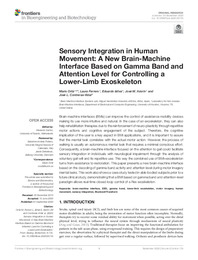Por favor, use este identificador para citar o enlazar este ítem:
https://hdl.handle.net/11000/6502Registro completo de metadatos
| Campo DC | Valor | Lengua/Idioma |
|---|---|---|
| dc.contributor.author | Ortiz, Mario | - |
| dc.contributor.author | Ferrero, Laura | - |
| dc.contributor.author | Iáñez Martínez, Eduardo | - |
| dc.contributor.author | Azorín Poveda, José María | - |
| dc.contributor.author | Contreras Vidal, José Luis | - |
| dc.contributor.other | Departamentos de la UMH::Ingeniería de Sistemas y Automática | es |
| dc.date.accessioned | 2020-10-15T07:28:11Z | - |
| dc.date.available | 2020-10-15T07:28:11Z | - |
| dc.date.created | 2020-06-10 | - |
| dc.date.issued | 2020-10-15 | - |
| dc.identifier.issn | 2296-4185 | - |
| dc.identifier.uri | http://hdl.handle.net/11000/6502 | - |
| dc.description.abstract | Brain-machine interfaces (BMIs) can improve the control of assistance mobility devices making its use more intuitive and natural. In the case of an exoskeleton, they can also help rehabilitation therapies due to the reinforcement of neuro-plasticity through repetitive motor actions and cognitive engagement of the subject. Therefore, the cognitive implication of the user is a key aspect in BMI applications, and it is important to assure that the mental task correlates with the actual motor action. However, the process of walking is usually an autonomous mental task that requires a minimal conscious effort. Consequently, a brain-machine interface focused on the attention to gait could facilitate sensory integration in individuals with neurological impairment through the analysis of voluntary gait will and its repetitive use. This way the combined use of BMI+exoskeleton turns from assistance to restoration. This paper presents a new brain-machine interface based on the decoding of gamma band activity and attention level during motor imagery mental tasks. This work also shows a case study tested in able-bodied subjects prior to a future clinical study, demonstrating that a BMI based on gamma band and attention-level paradigm allows real-time closed-loop control of a Rex exoskeleton. | es |
| dc.description.sponsorship | This research was funded by the Spanish Ministry of Science and Innovation through grant CAS18/00048 José Castillejo | - |
| dc.description.sponsorship | By the Spanish Ministry of Science and Innovation, the Spanish State Agency of Research, and the European Union through the European Regional Development Fund in the framework of the project Walk–Controlling lower-limb exoskeletons by means of brain-machine interfaces to assist people with walking disabilities (RTI2018-096677-B-I00); | - |
| dc.description.sponsorship | by theConsellería de Innovación, Universidades, Ciencia y Sociedad Digital (Generalitat Valenciana), | - |
| dc.description.sponsorship | the European Social Fund in the framework of the project Desarrollo de nuevas interfaces cerebro-máquina para la rehabilitación de miembro inferior (GV/2019/009). | - |
| dc.description.sponsorship | Authors would like to thank especially Kevin Nathan and the rest of the laboratory of JC-V for their help during the experimental trials, and Atilla Kilicarslan for his help with the implementation of H1 algorithm | - |
| dc.format | application/pdf | es |
| dc.format.extent | 16 | es |
| dc.language.iso | eng | es |
| dc.rights | info:eu-repo/semantics/openAccess | es |
| dc.subject | brain-machine interface | es |
| dc.subject | EEG | es |
| dc.subject | gamma band | es |
| dc.subject | lower-limb exoskeleton | es |
| dc.subject | motor imagery | es |
| dc.subject | human movement | es |
| dc.subject | sensory integration | es |
| dc.subject | Stockwell Transform | es |
| dc.subject.other | 62 - Ingeniería. Tecnología | es |
| dc.title | Sensory Integration in Human Movement: A New Brain-Machine Interface Based on Gamma Band and Attention Level for Controlling a Lower-Limb Exoskeleton | es |
| dc.type | info:eu-repo/semantics/article | es |
| dc.identifier.doi | 10.3389/fbioe.2020.00735 | - |
| dc.relation.publisherversion | http://dx.doi.org/10.3389/fbioe.2020.00735 | - |

Ver/Abrir:
6-Sensory Integration in Human.pdf
6,72 MB
Adobe PDF
Compartir:
 La licencia se describe como: Atribución-NonComercial-NoDerivada 4.0 Internacional.
La licencia se describe como: Atribución-NonComercial-NoDerivada 4.0 Internacional.
.png)